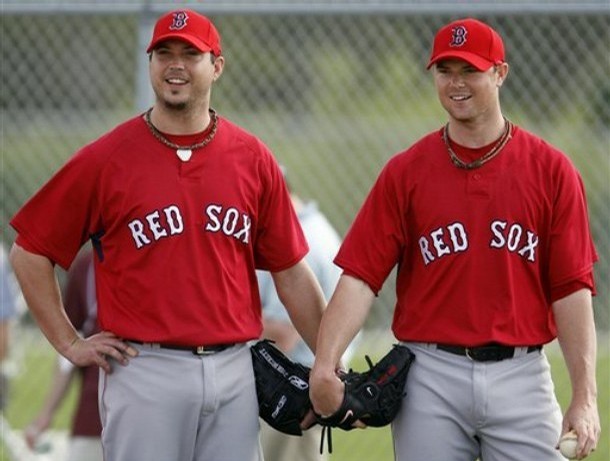Visits: 0
Let’s be frank; the Red Sox have been the ugliest story in baseball over the past 12 months. Maybe ownership and the fans didn’t make it clear enough. After a historic September meltdown in 2011, it was crucial for the Sox to come out of the gates quickly in 2012, but such a hot start never materialized. This year’s club has sputtered to an underwhelming 57-61 record in mid-August, good for only fourth in the competitive AL East.
Thank goodness that the mediocrity is explainable. Injuries destroyed (repeat, destroyed with a capital D) the Sox’s playoff hopes; things tend to fall apart when David Ortiz, Dustin Pedroia, Carl Crawford, Jacoby Ellsbury, Will Middlebrooks and Andrew Bailey all spend sizable chunks of time on the disabled list. New skipper Bobby Valentine has only made matters worse. His “take-no-prisoners” approach has clearly fractured a clubhouse still reeling from last year’s chicken-‘n-beer revelations and recent reports of player-owner conspiracies against him haven’t helped.
Nevertheless, the main reasons for the Sox’s poor performance sit at the top of their rotation: Josh Beckett and Jon Lester. You could argue that two pitchers will have less of an impact on a team’s performance than a loud manager and a lineup out of AMC’s “The Walking Dead”. However, when you pencil these pitchers in as the pillars of your rotation, you expect them to perform like such. Successful rotations are built on consistency, but when 40% of your starters can’t pull their own weight every five days, then you’ll have major issues.
Clearly, Beckett and Lester’s current campaigns do not line up with their general body of work.
Figure 1: Josh Beckett and Jon Lester, 2012 versus Career Averages
|
Games Started |
Record |
Winning Percentage |
Strikeouts |
Walks |
ERA |
WHIP |
|
|
Beckett 2012 |
‘20 |
5-10 |
.333 |
88 |
35 |
5.19 |
1.31 |
|
Beckett (Season Average) |
299 |
130-91
|
.588 |
117 |
47 |
3.93 |
1.23 |
|
Lester 2012 |
24 |
6-10
|
.375 |
129 |
44 |
5.20 |
1.37 |
|
Lester (Season Averages) |
179 |
82-44
|
.651 |
146 |
58 |
3.76 |
1.30 |
On the surface, both pitchers’ have WHIPs that are about 0.10 higher than their career averages. High WHIPs (i.e. 1.25 and up) cannot sustain low ERAs, so that’s where you get the bloated 2012 marks. Win-loss records generally stand independent from a hurler’s performance, but when two starters have 5.19 and 5.20 ERAs on the season, they won’t be winning many games.
Beckett’s inconsistencies stem from an inability to make hitters swing and miss. His 6.53 K/9 in 2012 is down significantly from his career 8.35 mark and it appears that he will not break 150 strikeouts for the first time since 2003 (excluding 2010, when he only started 6 games due to injury). Interestingly enough, Beckett has thrown his fastball far less this season (47.7% versus 62.2% career) while using his cutter at an all-time high (21.8% versus 5.3% career). Granted, the right-hander began utilized the second pitch in 2010, but has posted two of his three 5.00+ ERA seasons (2010 and 2012) since he added the cutter to his arsenal.
These trends suggest that Beckett no longer has confidence in his fastball, instead relying on a cutter that clearly isn’t getting the job done. As a result, his ground ball and strand rates have dropped (40.8% GB, 64.4% LOB in 2012 versus 43.9% GB, 71.7% LOB career), limiting his effectiveness.
Lester’s K/9 has also fallen this season (down to 7.90 from 8.33 over seven big-league season), but the long ball has done more to sabotage the southpaw in 2012. He has allowed 1.10 home runs per nine innings, a far cry from his 0.84 career HR/9. In other words, about one of every seven Lester fly balls have gone for round-trippers this season, while only one of ten have left the yard over his career. Again, pitch type tells the story; a career-high changeup usage (12.9% in 2012, 8.2% all-time) suggests that he may be hanging breaking balls for bad results.
Hitters may also be getting lucky against Lester this year. The hurler’s .272 BAA stands about 30 points higher than his .246 lifetime mark, but there is a 21-point gap between 2012 and career BABIP (.323 versus .302); additionally, his 3.91 FIP and 3.60 xFIP starkly contrast with his 5.20 ERA. The defense may be to blame here, since three notable Gold Glove winners (Pedroia, Ellsbury, and Crawford) missed significant time with injuries.
Beckett sits in a similar position with his 5.19 ERA, 4.13 FIP, and 4.37 xFIP, but regardless of bad luck and shoddy fielding, he and Lester need to step up. At 6.5 games out of the second wild card, the postseason is probably unrealistic for 2012, especially with a pitching staff that cannot carry the offense. If the Red Sox want to contend in the future, Beckett and Lester must perform, even if the approximate $41 million in combined 2013-2014 salary is a gross overpayment for 3.93 and 3.76 ERAs.








You must be logged in to post a comment Login